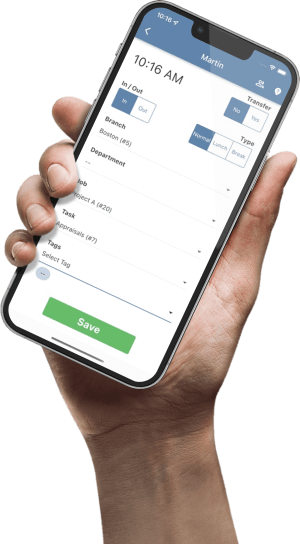
BIPA in Illinois: Navigating Compliance with Workforce Management Technology
TL;DR: The Illinois Biometric Information Privacy Act (BIPA) is a strict law regulating how businesses collect, use, and store biometric data like fingerprints and facial scans. For small businesses using biometric timeclocks, non-compliance can lead to expensive class-action lawsuits. BIPA requires you to 1) have a public written policy, 2) inform individuals in writing before collection, 3) state the purpose and retention term, and 4) get a written (now including electronic) release. A crucial August 2024 amendment changed liability from a "per-scan" to a "per-person" basis, reducing the risk of catastrophic damages but keeping compliance essential. This guide breaks down BIPA's requirements, the history of its litigation, the impact of the 2024 amendment, and analyzes how a comprehensive workforce management solution like TimeTrex can help you achieve BIPA compliance.
Article Index
The Foundation and Framework of BIPA
The Illinois Biometric Information Privacy Act (BIPA), enacted in 2008, is the most formidable biometric privacy law in the United States. For Illinois businesses, especially those using modern workforce management technology like biometric timeclocks, understanding BIPA is not just good practice—it's a critical defense against devastating financial liability. Its stringent rules and a powerful private right of action mean that even simple technical mistakes can trigger costly lawsuits.
The Genesis and Intent of BIPA
BIPA was born from a real-world threat. The Illinois General Assembly passed the Act in response to the bankruptcy of a company called Pay By Touch, which used fingerprints for payment authentication. Its failure sparked fears that its massive database of biometric data—which, unlike a password, can never be changed—could be sold off as a simple asset. This event highlighted that biometric data is unique and permanent. Once compromised, an individual is at a perpetual risk of identity theft.
The law's intent was not to ban biometric technology but to ensure individuals remain in control of their unique data. What makes BIPA so potent is its private right of action. Any person "aggrieved" by a violation can file a lawsuit for statutory damages, and courts have affirmed that a plaintiff doesn't need to prove actual harm like financial loss. The mere violation of the law is the injury, creating fertile ground for class-action lawsuits.
Deconstructing BIPA's Core Mandates (Section 15)
Section 15 of BIPA is the operational heart of the law, outlining the non-negotiable duties for any private entity handling biometric data. Compliance starts with understanding what "biometric data" is. The law defines a "biometric identifier" as a retina or iris scan, fingerprint, voiceprint, or a scan of hand or face geometry. "Biometric information" is any information based on an identifier that's used to identify someone—like the encrypted data template created from a facial scan.
Here are the core pillars of BIPA compliance:
- Publicly Available Written Policy (Sec. 15(a)): You must develop and publicly post (e.g., on your website) a written policy outlining your retention schedule and guidelines for permanently destroying biometric data.
- Data Retention and Destruction (Sec. 15(a)): You cannot keep biometric data forever. It must be destroyed when the initial purpose for collection is fulfilled (e.g., an employee is terminated) or within 3 years of the individual's last interaction with your company—whichever comes first.
- Informed Consent Before Collection (Sec. 15(b)): Before you collect any biometric data, you must:
- Inform the person in writing that their data is being collected.
- State the specific purpose and length of term for the collection and use.
- Obtain a written release (which, thanks to the 2024 amendment, now explicitly includes electronic signatures) from the person.
- Prohibition on Profiting (Sec. 15(c)): You cannot sell, lease, trade, or otherwise profit from an individual's biometric data.
- Restrictions on Disclosure (Sec. 15(d)): You cannot disclose biometric data to third parties unless you have consent for that specific disclosure or meet one of a few narrow exceptions (e.g., required by law). This is crucial when using a third-party vendor like a timeclock provider.
- Data Security (Sec. 15(e)): You must use a "reasonable standard of care" to store, transmit, and protect biometric data from disclosure, applying security measures at least as protective as those you use for other sensitive data like Social Security numbers.
| Requirement (Statutory Citation) | Mandate Details | Key Compliance Action |
|---|---|---|
| Develop Public Written Policy (Sec. 15(a)) | Policy must establish a retention schedule and guidelines for permanent data destruction. | Draft a BIPA-specific policy and publish it on your company's public-facing website. |
| Data Destruction (Sec. 15(a)) | Destroy data when the purpose is fulfilled or within 3 years of last interaction, whichever is first. | Implement a process to track interaction dates, trigger data destruction, and document all events. |
| Provide Written Notice (Sec. 15(b)(1)) | Inform the individual in writing that biometric data is being collected or stored. | Create a clear, concise notice document to provide to every individual before data collection. |
| State Purpose & Term (Sec. 15(b)(2)) | The written notice must state the specific purpose (e.g., "employee timekeeping") and retention term (e.g., "duration of employment"). | Ensure your notice document explicitly contains this information. Vague language is a risk. |
| Obtain Written Release (Sec. 15(b)(3)) | Receive an informed written release (including electronic signature) from the subject. | Obtain a signed consent form (physical or electronic) from each individual before their first use of the biometric system. Securely store these forms. |
| Prohibit Profiting (Sec. 15(c)) | Do not sell, lease, trade, or otherwise profit from biometric data. | Ensure no commercialization of biometric data. Review vendor contracts carefully. |
| Limit Disclosure (Sec. 15(d)) | Do not disclose data to third parties without consent or other narrow exceptions. | If using a third-party vendor, the written release must explicitly name the vendor and authorize the disclosure of data to them. |
| Implement Data Security (Sec. 15(e)) | Use a reasonable standard of care and protect data at least as well as other sensitive information. | Implement security measures like encryption for data in transit and at rest, strong access controls, and regular security audits. |
The High-Stakes World of BIPA Litigation
For years, BIPA was a little-known law. That changed dramatically with a series of Illinois Supreme Court rulings that expanded its power and created a tidal wave of class-action lawsuits against businesses.
Key Rulings That Defined a Decade of Risk
- Rosenbach v. Six Flags (2019): The court ruled that a plaintiff does not need to show actual harm (like identity theft) to sue. A simple procedural violation—like collecting a fingerprint without proper consent—is the injury. This decision opened the floodgates for litigation.
- McDonald v. Symphony Bronzeville Park (2022): The court decided that BIPA claims are not barred by the Illinois Workers' Compensation Act. This eliminated a key defense for employers, confirming they could be sued directly by their employees for BIPA violations.
- Tims v. Black Horse Carriers (2023): The court established a five-year statute of limitations for all BIPA claims, significantly expanding the look-back period for which a company could be held liable for past compliance failures.
The Billion-Dollar Question: Cothron v. White Castle
The most alarming ruling for businesses came in Cothron v. White Castle (2023). The court was asked whether a BIPA violation occurs only at the first improper scan or with every single scan. In a landmark decision, the court held that a new claim accrues with each and every scan or disclosure. This "per-scan liability" interpretation created the risk of what the court itself called "annihilative" damages. For example, White Castle calculated its potential liability at over $17 billion. This ruling made it nearly impossible for companies to risk a trial and was the direct catalyst for the 2024 legislative amendment.
The Shared Burden: Vendor Liability
Plaintiffs soon began targeting not just employers but also the technology vendors who supply biometric systems, like timeclock providers. Courts have found that vendors who design the systems, process the biometric templates, and store the data on their servers can be considered to "collect" and "possess" the data, making them independently liable under BIPA. This established a system of shared liability, making comprehensive vendor due diligence and strong contractual protections more critical than ever.
| Case Name (Year) | Central Legal Question | Court's Holding & Practical Implication |
|---|---|---|
| Rosenbach v. Six Flags (2019) | Must a plaintiff allege actual harm to sue? | No. A violation of the statutory right is a sufficient injury. This opened the floodgates for class-action lawsuits. |
| McDonald v. Symphony Bronzeville (2022) | Does Workers' Comp bar employee BIPA claims? | No. BIPA protects privacy rights, a different type of harm. This eliminated a primary employer defense. |
| Tims v. Black Horse Carriers (2023) | What is the statute of limitations? | A uniform five-year period. This significantly expanded the look-back period for potential liability. |
| Cothron v. White Castle (2023) | Do claims accrue with every scan? | Yes. This created the risk of "annihilative" per-scan damages and forced legislative intervention. |
| Figueroa v. Kronos Inc. (2020) | Can a third-party tech vendor be liable? | Yes. Vendors who design and operate systems can be "collectors," establishing shared liability. |
A New Paradigm: The August 2024 BIPA Amendment
Responding to the risk of "ruinous" liability created by the Cothron decision, the Illinois legislature passed Senate Bill 2979, which was signed into law on August 2, 2024. This amendment fundamentally rebalanced the BIPA risk equation for businesses.
Reversing the Tide: From Per-Scan to Per-Person Damages
The most important change is the direct reversal of the Cothron ruling. The amendment introduces a "single violation" rule. It clarifies that collecting the same biometric identifier from the same person using the same method multiple times counts as only a single violation. This means an employee who scans their fingerprint 1,000 times without proper consent can now only generate one claim for statutory damages ($1,000 for negligent, $5,000 for reckless/intentional), not 1,000 separate claims. While still substantial in a class-action context, this removes the existential threat of multi-billion-dollar judgments for a single oversight.
Modernizing Consent: Codifying Electronic Signatures
The amendment also provided a crucial update by officially adding "electronic signature" to the definition of a "written release." This resolves long-standing ambiguity and gives businesses clear legal authority to use modern, digital workflows—such as HR onboarding systems or e-signature platforms—to obtain and manage BIPA consents. This streamlines compliance and creates a more robust, auditable trail of consent.
Case Study: TimeTrex Workforce Management Under the BIPA Microscope
To see how BIPA applies in the real world, let's analyze TimeTrex's workforce management software, which includes a biometric facial recognition timeclock feature.
Analyzing the Technology
TimeTrex's facial recognition system is designed to "eliminate buddy punching" by verifying an employee's identity with a quick scan. This process collects a "scan of face geometry," which is a "biometric identifier" under BIPA. TimeTrex states that this data is converted into encrypted digital codes, not stored as photos. While this is a strong security measure, these encrypted codes are still "biometric information" under BIPA because they are based on an identifier and used for identification. Therefore, all BIPA rules apply.
Because TimeTrex is a cloud-based service, the biometric information is transmitted to TimeTrex's servers. This is a "disclosure" under BIPA and requires specific employee consent. The employer and TimeTrex share responsibility for compliance.
Evaluating TimeTrex's BIPA Compliance Framework
TimeTrex demonstrates a sophisticated understanding of BIPA by providing customers with a "Biometric Information Privacy Policy" template and a "Biometric Information Privacy Release Form." These documents are designed to help employers meet BIPA's core requirements, including notice, consent, purpose limitation, and data destruction rules. The release form correctly includes a section where the employee can authorize the disclosure of their data to TimeTrex as the vendor.
However, these are templates. Their existence alone does not guarantee compliance. The employer is still responsible for correctly implementing the policy and obtaining consent from every employee before the first scan.
| TimeTrex Feature | BIPA Section Implicated | Inherent Risk & Required Employer Action | Vendor (TimeTrex) Responsibility |
|---|---|---|---|
| Facial Recognition Clock-In | Sec. 15(b) - Collection | Risk: Collecting a face scan without prior written notice and release. Action: Provide every employee a BIPA notice and get a signed release (electronic or physical) BEFORE their first clock-in. | Provide the technology and compliance templates. Securely process the scan. |
| Cloud-Based Data Storage | Sec. 15(d) - Disclosure Sec. 15(e) - Data Security |
Risk: Disclosing data to TimeTrex without consent; risk of a vendor-level breach. Action: The consent form must authorize disclosure to TimeTrex. Vet vendor security and have a strong contract. | Securely store and transmit data using a reasonable standard of care (e.g., encryption). Notify the employer immediately of any security incident. |
| Data Retention on Servers | Sec. 15(a) - Destruction | Risk: Retaining data beyond the legal limit. Action: Have a process to notify TimeTrex upon employee termination to initiate data destruction and keep logs. | Permanently destroy data upon receiving a valid request from the employer. |
| Encrypted Digital Template | Sec. 10 - Biometric Information | Risk: Mistakenly believing an encrypted "template" isn't regulated. Action: Understand that any data based on a biometric identifier is covered by BIPA and apply all rules. | Be transparent that templates are subject to biometric privacy laws and do not create an exemption. |
Strategic Recommendations for BIPA Compliance
Even with the 2024 amendment, BIPA compliance remains critical. A proactive and well-documented program is your best defense.
1. Build a Foundational BIPA Compliance Program
- Policy: Develop a clear, public BIPA policy detailing what you collect, why, and your retention/destruction schedule.
- Consent: Use the new law to your advantage. Integrate an electronic consent form into your digital onboarding process. Make it a mandatory, non-skippable step before any employee is enrolled in a biometric system.
- Lifecycle Management: Don't just collect and forget. Implement a reliable, auditable process to enforce your data destruction policy. Track employee separation dates and send formal destruction requests to your vendor. Keep records of everything.
2. Conduct Rigorous Vendor Due Diligence
- Vetting: Go beyond marketing claims. Demand detailed documentation on your vendor's security architecture, encryption methods, and data handling policies. A vendor like TimeTrex that provides BIPA-specific documentation is a good start.
- Contractual Safeguards: Your service agreement is your legal shield. Insist on a strong indemnification clause requiring the vendor to cover costs arising from their negligence or security failures. A detailed Data Processing Addendum (DPA) is also essential.
3. Audit, Train, and Maintain
- Audits: Periodically audit your BIPA program. Check that consent forms are on file for every user and that your data destruction process is working.
- Training: Train HR staff and managers on the absolute importance of getting consent before enrollment. They must understand the process and know that they cannot penalize an employee for refusing consent.
- Stay Informed: BIPA law continues to evolve. Assign someone to monitor legal developments to ensure your program remains compliant.
Ready to Secure Your Workforce Management?
Navigating BIPA compliance requires the right tools and a knowledgeable partner. TimeTrex offers a comprehensive, cloud-based workforce management solution with built-in features and compliance templates designed to help you meet your BIPA obligations with confidence.
Discover TimeTrex Workforce Management SoftwareDisclaimer: The content provided on this webpage is for informational purposes only and is not intended to be a substitute for professional advice. While we strive to ensure the accuracy and timeliness of the information presented here, the details may change over time or vary in different jurisdictions. Therefore, we do not guarantee the completeness, reliability, or absolute accuracy of this information. The information on this page should not be used as a basis for making legal, financial, or any other key decisions. We strongly advise consulting with a qualified professional or expert in the relevant field for specific advice, guidance, or services. By using this webpage, you acknowledge that the information is offered “as is” and that we are not liable for any errors, omissions, or inaccuracies in the content, nor for any actions taken based on the information provided. We shall not be held liable for any direct, indirect, incidental, consequential, or punitive damages arising out of your access to, use of, or reliance on any content on this page.
About The Author

Roger Wood
With a Baccalaureate of Science and advanced studies in business, Roger has successfully managed businesses across five continents. His extensive global experience and strategic insights contribute significantly to the success of TimeTrex. His expertise and dedication ensure we deliver top-notch solutions to our clients around the world.
Time To Clock-In
Start your 30-day free trial!
Experience the Ultimate Workforce Solution and Revolutionize Your Business Today
- Eliminate Errors
- Simple & Easy To Use
- Real-time Reporting

Saving businesses time and money through better workforce management since 2003.
Copyright © 2025 TimeTrex. All Rights Reserved.
